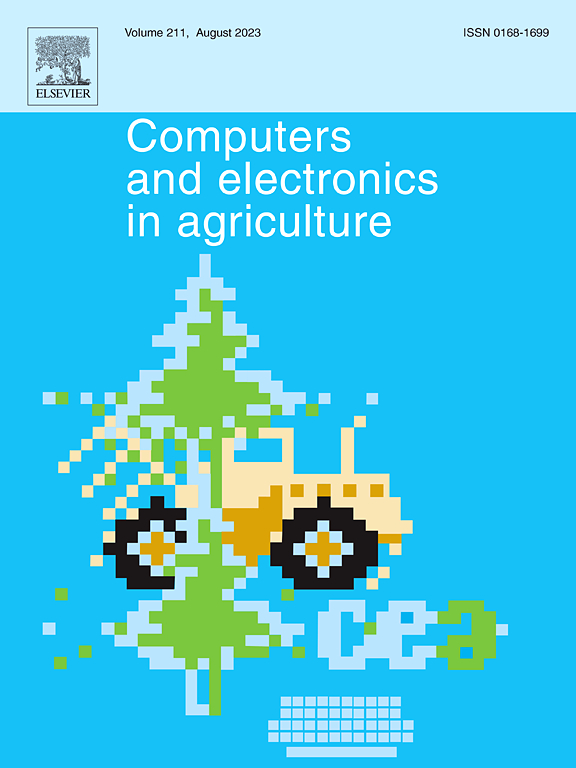农田有效管理的多模式杂草侵害率预测框架
IF 8.9
1区 农林科学
Q1 AGRICULTURE, MULTIDISCIPLINARY
引用次数: 0
摘要
杂草作为农业生产的主要危害之一,利用多光谱传感器对其进行有效的田间管理已得到广泛的研究。在杂草精准防治领域,杂草侵染率是杂草危害的重要指标,已有多种方法对其进行预测,并尝试应用于无人机指导农药喷洒。然而,现有的预测方法不仅面临数据类型稀缺的问题,而且大多数预测方法都需要像素级标记,这使得它们难以实际应用。处理多模式数据缺乏一致性也具有挑战性,这导致无法量化杂草和作物之间特征的差异。为了解决上述问题,我们利用无人机和多光谱相机采集了包含1495对可见和红外图像的早期辣椒杂草多模态数据库(PWMD)。此外,我们进一步设计了一个多模式杂草侵染率预测系统(MWPS),以实现高效的田间性能。MWPS实现了双路径生成对抗学习和多级特征匹配模块来缓解多模态图像之间的模态差异,并利用包含双注意的多层感知器模型来实现高效的杂草侵害率预测。在我们的数据集上进行实验验证,我们提出的框架预测田间杂草率的均方误差为0.12,平均绝对误差仅为0.09。本研究提出了一种有效的田间杂草管理新方法。代码和数据集可从http://wirps.samlab.cn获得。本文章由计算机程序翻译,如有差异,请以英文原文为准。
Multimodal weed infestation rate prediction framework for efficient farmland management
Weed, as one of the main hazards of agricultural production, is being widely studied for efficient field management via Multi-spectral sensors. In the field of precision weed control, the weed infestation rate is an important indicator of weed damage, which has been predicted by various methods and attempts to be applied to guide pesticide spraying via UAVs. However, existing prediction methods not only face the problem of scarcity of data types, but most of them also require pixel-level labeling, which makes them difficult to apply practically. It is also challenging to deal with the lack of consistency in multimodal data, which leads to an inability to quantify differences in characteristics between weeds and crops. To address the above problems, we collect a multimodal database (PWMD) of early pepper weeds containing 1495 pairs of visible and infrared images using a UAV and a multispectral camera. Moreover, we further design a multimodal weed infestation rate prediction system (MWPS) to achieve efficient performance in the field. In detail, MWPS implements dual-path generative adversarial learning and a multilevel feature matching module to mitigate modal differences between multimodal images and utilizes a multilayer perceptron model containing dual attention to achieve efficient weed infestation rate prediction. Experimentally validate on our dataset, our proposed framework has a mean square error of 0.12 and a mean absolute error of only 0.09 for the prediction of field weed rates. This study proposes an effective new method for distal field weed management. Code and dataset are available at http://wirps.samlab.cn.
求助全文
通过发布文献求助,成功后即可免费获取论文全文。
去求助
来源期刊

Computers and Electronics in Agriculture
工程技术-计算机:跨学科应用
CiteScore
15.30
自引率
14.50%
发文量
800
审稿时长
62 days
期刊介绍:
Computers and Electronics in Agriculture provides international coverage of advancements in computer hardware, software, electronic instrumentation, and control systems applied to agricultural challenges. Encompassing agronomy, horticulture, forestry, aquaculture, and animal farming, the journal publishes original papers, reviews, and applications notes. It explores the use of computers and electronics in plant or animal agricultural production, covering topics like agricultural soils, water, pests, controlled environments, and waste. The scope extends to on-farm post-harvest operations and relevant technologies, including artificial intelligence, sensors, machine vision, robotics, networking, and simulation modeling. Its companion journal, Smart Agricultural Technology, continues the focus on smart applications in production agriculture.
 求助内容:
求助内容: 应助结果提醒方式:
应助结果提醒方式:


